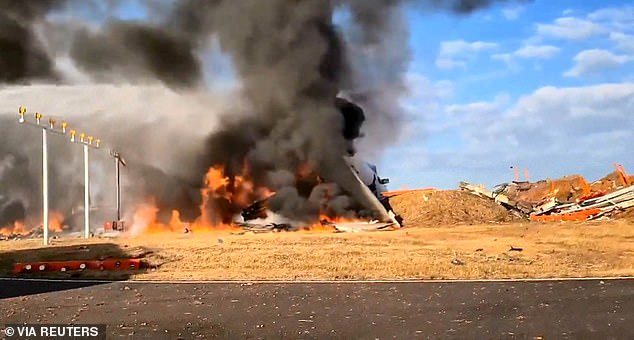First there was the terrible weather and reports of a ‘wall’ of geese. Next, an aborted first landing at Muan International Airport in South Korea.
Then a catastrophic second attempt – which saw Jeju Air’s flight 7C2216 hurtle down the runway, veer to one side and smash into a concrete wall.
The impact was devastating: the Boeing 737-800 burst into a giant fireball as the surrounding area was littered with seats, cushions, magazines, handbags and shoes.
Of the 181 people on board – mostly Korean nationals on their way home from the Thai capital of Bangkok – just two cabin crew members survived. Everyone else – including three generations of one family and the pilot – were killed.
Sunday’s tragedy marked the deadliest aviation disaster in South Korea in almost 30 years. But it has also thrown the global airline industry into turmoil as theories and counter-theories swirl.
Here, with the help of renowned aviation security expert Julian Bray, Jane Fryer unpicks the nine unanswered questions of the doomed South Korean jet.

The blaze after the plane crash in South Korea, which was the deadliest aviation disaster in the country in almost 30 years
COULD IT HAVE BEEN NORTH KOREAN SABOTAGE?
During the first, aborted descent, witnesses on the ground said they heard a bang and saw a ring of smoke rising from one of the wings.
This could, theoretically, have been caused by a bomb hidden in a suitcase in the hold, but such an explanation is highly unlikely. The plane could also have been hit by a missile.
One other possibility is that a highly trained service agent severed the hydraulic cables. Though as Mr Bray puts it: ‘Now we are really getting into James Bond territory.’
Hijacking is also unlikely. Not least because, in his communications running up to the crash, the pilot sounds calm and composed, deploying no key security words or pressing any alarms.
But however implausible they might sound, investigators will have to examine all possibilities before ruling them out.
WAS A ‘BIRD STRIKE’ REALLY THE CAUSE?
Bird strikes – collisions between a plane or drone in flight and a bird – are common. In the UK, there were more than 1,400 bird strikes reported in 2022, of which about 100 resulted in damage to the aircraft concerned.
In this case, all the signs point to a bird strike. There were reports of a ‘wall’ of geese in the vicinity of the airport and, at 8.57am on Sunday morning, air traffic control warned of bird activity in the area. Two minutes later, the pilot gave the call ‘mayday, mayday, mayday’ and ‘bird strike, bird strike, go-around’, abandoning his first landing.
Around that time, a passenger messaged a relative to say that they had seen ‘a bird caught in the wing’ – this coincided with onlookers noticing the bang and a ring of smoke.

The wreckage of flight 7C2216 at Muan International Airport
‘This could be the engine bottling up pressure after ingesting the bird, which is suddenly released. Or could be the engine giving up,’ says Mr Bray.
‘And one of the turbo fans made of carbon fibre could have sheared off and cut a hydraulic line [which controls the landing gear and brake plates].’
But a bird in the engine could only ever be part of the problem. Hydraulics are deliberately split up to avoid this sort of disaster, and there are also several back-up systems in case of failure.
WHY WAS THE SECOND LANDING ATTEMPT A DISASTER?
By the time the pilot was circling for his second landing attempt, he knew that he was in trouble.
There are two methods of slowing down a jet plane while landing. Firstly, using the flaps on the wings to act as an air braking system – these can be extended to a 45-degree angle to increase the area of the wing and therefore reduce speed.
Secondly, when the plane hits the runway, the ‘reverse thrust system’ acts like an air brake to bring the aircraft down to a safe speed.
Both have back-up systems – automatic and manual – in case of emergency.
However, it appears that neither of these systems functioned properly on flight 7C2216, as the plane hurtled on to the runway at full velocity and landed on its belly in a textbook emergency landing.
But with no wheels, the pilot had no way of steering as the plane sped down the runway – nor when it veered off to the right, towards the solid concrete wall, and exploded in a huge fireball.
WHAT WAS A CONCRETE WALL DOING ON THE RUNWAY?
This wall housed an antenna base to help planes land in poor weather. Usually an antenna base near the runway would be collapsible, but this one had brick pillars and was filled with blocks.
Mr Bray explains: ‘There is an international code that governs the design of airports to keep them safe.

The Jeju Air aircraft is seen going down the runway before crashing

Firefighters search the wreckage of the plane, after the disaster that killed 179 people
‘Usually any barriers are limited to hedges and chain-link fences with concrete posts, which would slow the aircraft, but not destroy it on impact.
‘This is very odd and needs investigating because of course it should not have been here.’
WAS THERE A PROBLEM WITH THE PILOT?
There are no current indications the pilot was suicidal, but all options will be considered.
It is also not clear whether there were one or two pilots on the flight deck. Cost-cutting across airlines has resulted in the ‘single-manning’ of some cockpits.
COULD THE RUNWAY HAVE BEEN TO BLAME?
At 2,800m, this was a long runway and – in usual circumstances – would be more than sufficient.
After the initial aborted landing, the pilot announced that he was going to ‘go around’ and take the runway from the opposite direction. He did not ask the air traffic team but simply informed them – probably because he was unable to turn the plane around as the controls were unresponsive, Mr Bray suggests.
There is nothing sinister about coming at the runway from a new direction. All busy airports have two-way traffic.
At Heathrow, planes land in one direction before noon and the other way in the afternoon to avoid the sun.

Kang Ko, Jin Lee Seon and their son died on board the flight. They shared pictures of their first family holiday on Instagram
In an emergency like this, air traffic controllers would already have cleared the runway and the area around it, and got the fire engines on standby.
DID THE WEATHER PLAY A PART IN THE CRASH?
A severe weather warning had been issued, but experts consider bad weather a red herring.
‘This was an experienced pilot with 9,800 flying hours. He knew what he was doing,’ says Mr Bray.
COULD THE PLANE’S BLACK BOXES REVEAL ANYTHING?
Every plane carries a voice data box and a data recorder. Known collectively as the black boxes, they are, in fact, bright orange and were kept up high near the rear exit on this plane.
The voice data box is a continuous recording device, saving and timecoding all conversations in the cockpit between the pilots and communications with air traffic control in the hour before the crash.
The data recorder tracks every movement the pilot makes – buttons pushed, switches flicked and so on – in the same time period.
The recordings can take weeks to decode but together can help build up a complete picture. However, in this case, the data recorder is damaged, which could hamper investigations.
WHAT WILL HAPPEN IN THE AFTERMATH?
No expense will be spared in the investigations to find out what went wrong – not least because there are 5,000 Boeing 737-800s jetting around the world.
As well as decoding the black boxes and unravelling the plane’s last minutes, workers will rebuild the plane using a skeleton frame and all the pieces of fuselage they can salvage from the debris field.
By analysing the fragments, a more complete picture can be built. For example, if the shrapnel bends outwards, this could indicate an explosion on board. If inwards, this could be a sign of an external force such as a missile.







